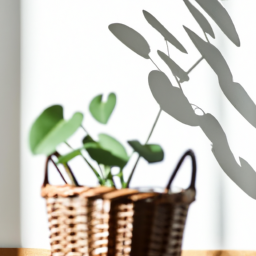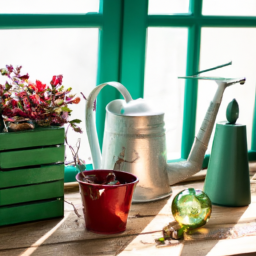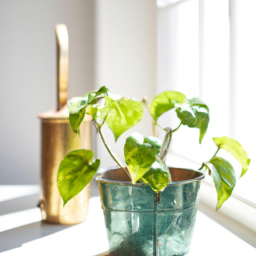
Have you ever wondered which of your beloved indoor plants can thrive outdoors? Many plant enthusiasts find themselves pondering this question when the warmer months arrive. Whether you want to introduce some greenery to your garden or simply give your houseplants a breath of fresh air, knowing which indoor plants can go outside is essential. In this blog post, we will explore the exciting world of transitioning indoor plants to the great outdoors. So, if you’re eager to learn how to successfully relocate your green companions, keep reading!
Benefits of Transitioning Indoor Plants to Outdoor Environments
Indoor plants are not only a beautiful addition to our homes, but they also provide numerous benefits to our overall well-being. However, many indoor plants can actually thrive when given the opportunity to be placed outside. Transitioning indoor plants to outdoor environments can bring a whole new level of benefits to both the plants and the plant owners. In this article, we will explore the various advantages of moving indoor plants outdoors and provide you with a step-by-step guide on how to successfully transition your plants.
Improved Air Quality
One of the primary benefits of transitioning indoor plants to outdoor environments is the significant improvement in air quality. While indoor plants do a great job of purifying the air inside our homes, they have limited access to fresh air. By moving them outside, plants can take advantage of natural ventilation and a constant supply of fresh air, resulting in even better air purification. Outdoor environments also provide a more natural balance of humidity, which can benefit the overall health of the plants.
Additionally, outdoor spaces have a larger volume of air, allowing for better dispersion of any potential pollutants. This leads to a cleaner and healthier environment for both the plants and the people around them. Studies have shown that spending time in green spaces can also improve human health by reducing stress levels and increasing overall well-being.
When transitioning your indoor plants outdoors, it is important to consider the specific needs of each plant. Some plants may require more shade or protection from strong winds, while others may thrive in direct sunlight. Researching the specific requirements of your plants will help ensure a successful transition.
Increased Growth and Vitality
Another significant benefit of moving indoor plants outside is the potential for increased growth and vitality. While indoor conditions may provide sufficient light for many plants, natural sunlight is often much stronger and more beneficial. Outdoor environments offer a wider spectrum of light, including ultraviolet (UV) rays, which can stimulate plant growth and enhance their overall health.
Plants exposed to natural sunlight also tend to develop stronger stems and leaves. The increased light intensity outdoors can encourage plants to produce more chlorophyll, which is essential for photosynthesis. This, in turn, leads to more efficient energy production and better overall growth.
However, it is important to note that not all indoor plants will thrive in direct sunlight. Some plants may require partial shade or filtered light to prevent their leaves from burning. Before transitioning your plants outdoors, make sure to research their specific light requirements and gradually acclimate them to the increased light levels.
Enhanced Pest Control
Bringing indoor plants outdoors can also provide a natural form of pest control. Many indoor plants are susceptible to pests such as aphids, spider mites, and mealybugs. By exposing these plants to outdoor environments, natural predators like ladybugs and lacewings can help keep these pests in check.
Outdoor environments also offer a more diverse ecosystem, allowing beneficial insects to thrive. These insects can help control pest populations and prevent infestations, reducing the need for chemical pesticides. However, it is important to monitor your plants regularly for any signs of pest damage and take appropriate action if necessary.
When transitioning your indoor plants outdoors, it is crucial to inspect them for any existing pests. Treating any pest infestations before moving the plants outside will help prevent the spread of pests to other plants or the surrounding environment.
In conclusion, transitioning indoor plants to outdoor environments can bring numerous benefits, including improved air quality, increased growth and vitality, and enhanced pest control. However, it is important to research the specific needs of each plant and gradually acclimate them to the outdoor conditions. By following these steps, you can enjoy the beauty and benefits of your indoor plants in a whole new way.

Best Indoor Plants for Outdoor Gardens: A Comprehensive Guide
Hello there! If you’re wondering which indoor plants can thrive in your outdoor garden, you’ve come to the right place. In this comprehensive guide, we will explore some of the best indoor plants that can transition successfully to the great outdoors. So, let’s get started and bring some greenery to your garden!
1. Succulents
Succulents are excellent choices for outdoor gardens due to their ability to adapt to various climates and their low maintenance requirements. These hardy plants store water in their leaves, making them perfect for dry and sunny outdoor environments. Here are a few popular succulents that can make a great addition to your garden:
Aloe Vera: Known for its medicinal properties, Aloe Vera is a versatile plant that thrives both indoors and outdoors. It loves direct sunlight and well-drained soil, making it a perfect choice for your garden.
Jade Plant: With its thick, fleshy leaves, the Jade Plant is a beautiful addition to any garden. It can tolerate full sun but also grows well in partial shade. Just make sure the soil is well-drained to avoid overwatering.
Hens and Chicks: Hens and Chicks, also known as Sempervivum, are small, rosette-shaped succulents that can tolerate cold temperatures. They are perfect for rock gardens or as ground covers in your outdoor space.
2. Tropical Foliage Plants
If you’re looking to add a touch of the tropics to your outdoor garden, tropical foliage plants are the way to go. These plants thrive in warm and humid conditions, making them perfect for outdoor gardens in tropical or subtropical regions. Here are a few popular choices:
Bird of Paradise: With its vibrant orange and blue flowers, the Bird of Paradise is a stunning addition to any garden. It loves full sun and can tolerate a wide range of soil conditions, making it a versatile choice for your outdoor space.
Elephant Ear: Known for its large, heart-shaped leaves, the Elephant Ear plant adds a dramatic touch to any garden. It thrives in partial shade and moist soil, making it an ideal choice for areas with high humidity.
Philodendron: Philodendrons come in various shapes and sizes, making them a versatile choice for outdoor gardens. They prefer partial shade and well-drained soil, and some varieties can even tolerate full sun.
3. Flowering Plants
Flowering plants add color and beauty to any garden, and many indoor flowering plants can also thrive outdoors. Here are a few popular choices that will brighten up your outdoor space:
Geranium: Geraniums are known for their vibrant flowers and long blooming season. They love full sun and well-drained soil, making them a popular choice for outdoor gardens.
Begonia: Begonias come in a wide range of colors and varieties, making them a versatile choice for any garden. They prefer partial shade and well-drained soil, and they can bloom from spring to fall.
Petunia: Petunias are popular annual flowers that come in various colors, including pink, purple, and white. They love full sun and well-drained soil, making them a great addition to your outdoor garden.
Now that you have a better idea of the best indoor plants that can go outside, it’s time to start planning your garden. Remember to consider the specific growing conditions of your outdoor space, such as sunlight exposure and soil type, to ensure the success of your chosen plants. Happy gardening!

Tips for Successfully Moving Indoor Plants Outside
Introduction
Moving indoor plants outside can be a rewarding experience for both the plants and the gardener. However, it is important to take certain precautions to ensure a smooth transition. In this guide, we will provide you with step-by-step tips on how to successfully move your indoor plants outside and help them thrive in their new environment.
Assessing Plant Suitability
Before moving your indoor plants outside, it is crucial to assess their suitability for outdoor conditions. Not all indoor plants are equipped to handle the harsher elements found outdoors. Here are some factors to consider:
Light Requirements
Indoor plants are accustomed to lower light levels compared to their outdoor counterparts. Before moving them outside, evaluate the amount of sunlight your outdoor space receives. If your plants have been thriving in low light conditions indoors, they may struggle to adapt to direct sunlight. Gradually acclimatize them by placing them in a partially shaded area at first, and gradually expose them to more sunlight over a period of weeks.
Temperature Tolerance
Indoor plants are typically kept in controlled environments with stable temperatures. Outdoor conditions can be more extreme, especially during summer and winter. Check the temperature range that your plants can tolerate and make sure your outdoor climate falls within that range. If not, consider moving your plants outside during milder seasons or providing them with additional protection during extreme weather events.
Watering and Humidity
Indoor plants are often watered more frequently due to the drier indoor air. When moving them outside, it is important to adjust your watering schedule accordingly. Outdoor plants may require less frequent watering, especially if your area experiences regular rainfall. Monitor the moisture levels in the soil and adjust your watering routine accordingly. Additionally, consider the humidity levels in your outdoor space. Some indoor plants thrive in higher humidity, so ensure your outdoor environment can provide the necessary moisture.
Preparing Plants for Outdoor Transition
Once you have assessed the suitability of your indoor plants for outdoor conditions, it’s time to prepare them for the transition. Follow these steps to ensure a successful move:
Gradual Acclimatization
Sudden changes in environment can shock and stress plants. To prevent this, gradually expose your indoor plants to outdoor conditions. Start by placing them in a shaded area outdoors for a few hours each day. Slowly increase the duration and intensity of their exposure to sunlight over a period of weeks. This will allow them to adjust to the new light levels and avoid sunburn.
Pest Prevention
Before moving your indoor plants outside, thoroughly inspect them for any signs of pests. Common indoor pests such as spider mites, aphids, and mealybugs can quickly spread to other outdoor plants. Treat any infestations before the move to prevent the pests from causing damage to your indoor plants or spreading to your garden.
Repotting and Pruning
If your indoor plants have outgrown their current pots, consider repotting them before moving them outside. Choose a pot that provides enough room for the roots to grow and has good drainage. Additionally, prune any dead or damaged foliage to promote healthy growth and reduce stress on the plants during the transition.
Caring for Outdoor Plants
Once your indoor plants have successfully made the move outside, it’s important to continue providing them with proper care. Here are some tips to ensure their well-being:
Watering
Outdoor plants may have different watering needs compared to their indoor counterparts. Monitor the moisture levels in the soil and water accordingly. Remember to consider rainfall in your area and adjust your watering schedule accordingly. Avoid overwatering, as it can lead to root rot and other issues.
Fertilizing
Outdoor plants may require more frequent fertilization compared to indoor plants. Choose a balanced, slow-release fertilizer and follow the instructions on the packaging. Apply the fertilizer during the growing season to provide your plants with the necessary nutrients for healthy growth.
Protection from Elements
While outdoor conditions can be beneficial for plants, they can also pose challenges. Protect your outdoor plants from extreme weather conditions such as strong winds, heavy rain, or frost. Use stakes or supports for taller plants to prevent them from toppling over during storms. Consider using mulch around the base of the plants to retain moisture and regulate soil temperature.
Conclusion
Moving your indoor plants outside can be a rewarding experience, but it requires careful planning and attention to detail. Assess the suitability of your plants for outdoor conditions, gradually acclimate them, and provide proper care once they are outside. By following these tips, you can ensure a successful transition and enjoy the beauty of your indoor plants in an outdoor setting. Happy gardening!
Crisp Recap
Indoor plants are a fantastic way to bring nature into our homes, but have you ever wondered if they can survive and thrive outside? Well, the good news is that some indoor plants can indeed make the transition to the great outdoors! While not all indoor plants are suitable for outdoor conditions, there are a few resilient varieties that can handle the change. Let’s take a look at some of these green beauties that can successfully venture into the wild.
One such plant is the Snake Plant, also known as Sansevieria. This hardy houseplant is famous for its ability to withstand neglect and low-light conditions, making it a perfect candidate for outdoor living. With its long, sword-shaped leaves and striking patterns, the Snake Plant can add a touch of elegance to any garden or patio. Another indoor plant that can thrive outdoors is the Spider Plant. Known for its cascading green foliage and tiny white flowers, this plant is a popular choice for hanging baskets. Spider Plants are adaptable and can handle different light conditions, making them a versatile addition to your outdoor space. Just be sure to gradually introduce them to direct sunlight to avoid leaf burn.
While it’s exciting to bring our beloved indoor plants outside, it’s important to note that not all plants can handle the transition. Some indoor plants are more delicate and require the controlled environment of our homes. So, before relocating your green companions, do some research and consider their specific needs. With the right care and attention, you can enjoy the best of both worlds by bringing a touch of nature to your indoor and outdoor spaces.
Your Burning Questions Answered:
Q1: Can indoor plants be placed outside?
A1: Yes, many indoor plants can thrive outdoors as long as they are gradually acclimated to the outdoor environment. It’s important to remember that not all indoor plants can tolerate direct sunlight or extreme temperatures, so it’s crucial to do some research on the specific plants you want to move outdoors.
Q2: Which indoor plants can be safely placed outside?
A2: Some common indoor plants that can be safely placed outside include pothos, spider plants, peace lilies, snake plants, and rubber plants. These plants are known for their adaptability and ability to withstand different light and temperature conditions.
Q3: How should I transition my indoor plants to the outdoors?
A3: Transitioning indoor plants to the outdoors should be done gradually to prevent shock. Start by placing them in a shaded area outdoors for a few hours each day, gradually increasing their exposure to sunlight over a period of one to two weeks. This will allow them to adjust to the higher light levels and outdoor conditions.
Q4: Are there any specific care requirements for indoor plants placed outside?
A4: Yes, when placing indoor plants outside, it’s important to consider their watering needs. Outdoor conditions may affect moisture levels, so you may need to adjust your watering routine accordingly. Additionally, be mindful of pests and diseases that may be more prevalent outdoors, and take necessary precautions to protect your plants.
Q5: Can I bring my outdoor-placed indoor plants back inside?
A5: Yes, you can bring your outdoor-placed indoor plants back inside, especially as the weather starts to change. However, just like the transition to the outdoors, you should acclimate them gradually to prevent shock. Start by bringing them indoors for a few hours a day and gradually increase their time indoors over a week or two.
Dr. Olivia Green is a botanist with over two decades of experience in indoor plant cultivation. She holds a Ph.D. in Plant Biology and has dedicated her career to researching plant behavior in controlled environments. Dr. Green is passionate about helping plant enthusiasts master the art of indoor gardening through her extensive knowledge and practical insights.


